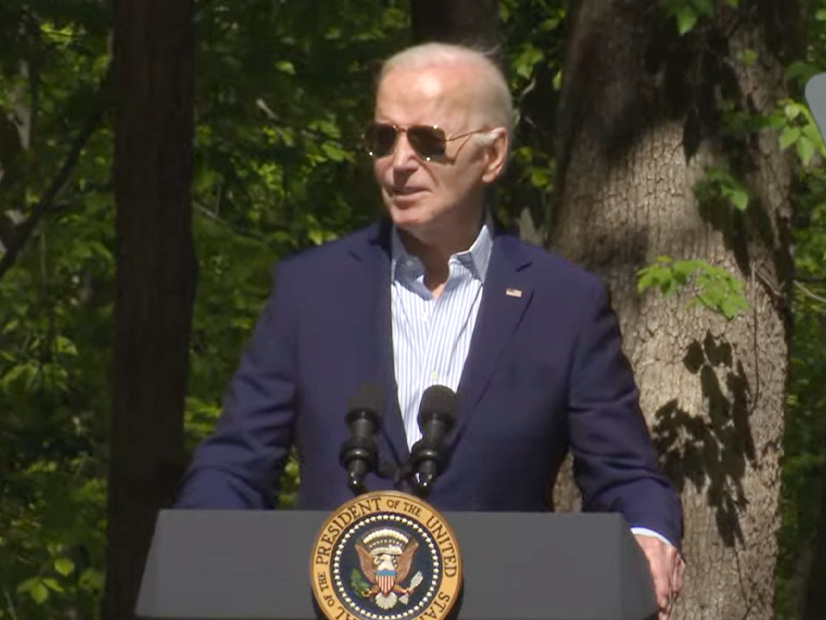
President Joe Biden on April 22 announced $7 billion in funding from the Inflation Reduction Act, to be used by states and nonprofits across the country to install solar in low-income and disadvantaged communities.
The Solar for All grants, part of the IRA’s Greenhouse Gas Reduction Fund, will fund 60 programs aimed at installing solar on low-income single-family and multifamily homes, as well as building community or shared solar programs that target consumers, such as renters, who cannot put solar on their roofs.
EPA, which is administering the program, estimates that Solar for All projects could save more than 900,000 households in low-income and disadvantaged communities $350 million annually.
Consumers who sign up for community solar programs typically receive credits on their utility bills. The selected awardees all have committed to providing at least 20% savings on utility bills for all households served by their projects, according to a senior administration official speaking on background.
Speaking in Prince William Forest Park in Virginia, Biden estimated households benefiting from Solar for All projects would save about $400 per year on utility bills.
“Energy costs are among the biggest costs for families … particularly for middle-income families,” he said. “In fact, low-income families can spend up to 30% of their paycheck on their energy bills. It’s outrageous.
“Solar for All will give us more breathing room and cleaner breathing room.”
The program also could add about 4 GW of distributed solar to local electric systems while cutting the equivalent of 30 million metric tons of carbon dioxide, according to EPA.
EPA Deputy Administrator Janet McCabe provided a breakdown of the funding during an April 19 press call: $5.5 billion will go to 49 state-level awards, $500 million to projects in tribal communities and $1 billion to multistate organizations serving low-income communities not well served by the private market.
Grant amounts range from $43.7 million to $249.8 million.
The multistate grants will “focus on low-income communities; communities around historically Black colleges and universities, Hispanic-serving institutions, and tribal colleges and universities; households served by rural and municipal electric co-ops; families in the industrial heartland; and low-income customers who are unable to build rooftop solar but could still benefit from community solar,” McCabe said.
The Clean Energy Fund of Texas will partner with the Bullard Center for Environmental and Climate Justice at Southern Texas University to provide technical assistance and grants for community solar projects in “low-income and disadvantaged communities on the frontlines of energy policy and grid vulnerability challenges,” according to EPA.
These projects also could include energy storage, to deliver “grid and community benefits by powering community resilience centers,” EPA said. While based in Texas, the program will fund projects in 19 Mid-Atlantic and Southeastern states, from Pennsylvania to Texas.
“EPA’s Solar for All awards will mean that low-income communities, and not just well-off communities, will feel the cost-saving benefits of solar,” John Podesta, White House senior adviser for international climate policy, said in a statement.
“Residential solar electricity leads to reduced monthly utility bills, reduced levels of air pollution in neighborhoods and ultimately healthier communities,” said Adrianne Todman, acting secretary of the Department of Housing and Urban Development.
Biden noted that Prince William Forest Park, now part of the National Park System, originally was developed by the Civilian Conservation Corps, a jobs program President Franklin D. Roosevelt launched in 1933.
The CCC was part of the inspiration for the American Climate Corps, which Biden also announced would accept applications for its initial 2,000 positions via a new website. First proposed in 2021, the initiative aims to provide corps members with jobs and training to mitigate climate change.
As part of the corps, they also will be able to access the North America’s Building Trades Unions’ (NABTU) apprenticeship-readiness program, Biden said. And the U.S. Office of Personnel Management will expand eligibility for federal employment to individuals who have completed qualifying career or technical education through Climate Corps programs.
Reactions
Clean energy and environmental advocates were mostly supportive of Solar for All while also warning of potential obstacles ahead.
Jeff Cramer, CEO of the Coalition for Community Solar Access, said the $7 billion in federal funds could “unlock multiples of private capital. … Community solar is a critical tool in the broader toolbox of distributed solar options for American households.”
Chelsea Barnes, director of government affairs and strategy for the nonprofit Appalachian Voices, called the program “a game-changer for so many under-resourced and environmental justice communities seeking a more sustainable, reliable, democratized energy system.”
“For vulnerable households that depend on electricity for their health and security, the solar and battery storage systems resulting from Solar for All could act as a literal lifeline during times of emergency,” said Marriele Mango, project director for the Clean Energy Group, which will receive funding from Solar for All as part of the Community Power Coalition.
But “smart state energy policies and streamlined implementation will determine whether American families ultimately see the savings from Solar for All on their electric bills,” said Harry Godfrey, managing director at Advanced Energy United. He pointed to “lengthy and burdensome interconnection requirements, bureaucratic permitting processes, and state energy policies and regulations that undervalue or simply obstruct community and distributed solar.”
In addition, awardees still must negotiate and finalize agreements with EPA before they can access the funds. EPA estimates all contracts will be finalized by Sept. 30.


